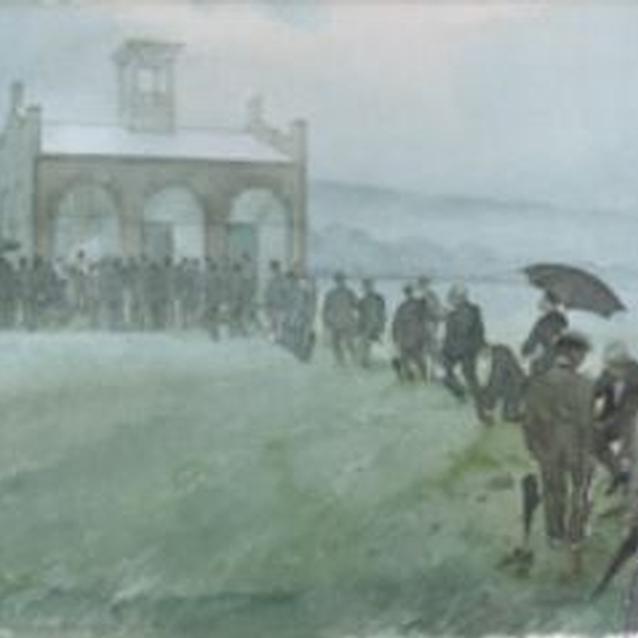At the dawn of the twentieth century, the outlook for full civil rights for African Americans was at a precarious crossroads. Failed Reconstruction and the Supreme Court's separate but equal doctrine (Plessy v. Ferguson), coupled with Booker T. Washington's accommodationist policies, threatened to compromise any hope for full and equal rights under the law.
"...one of the greatest meetings that American Negroes ever held." W.E.B. Dubois

National Parks Conservation Association
Harvard educated William Edward Burghardt Du Bois committed himself to a bolder course, moving well beyond the calculated appeal for limited civil rights. He acted in 1905 by drafting a "Call" to a few select people. The Call had two purposes: "organized determination and aggressive action on the part of men who believed in Negro freedom and growth," and opposition to "present methods of strangling honest criticism."
Du Bois gathered a group of men representing every region of the country except the West. They hoped to meet in Buffalo, New York. When refused accommodation, the members migrated across the border to Canada. Twenty nine men met at the Erie Beach Hotel in Ontario from July 11-14, 1905. The Niagarites adopted a constitution and by-laws, established committees and wrote a "Declaration of Principles," outlining the future for African Americans. After three days, they returned across the border with a renewed sense of resolve in the struggle for freedom and equality.
Thirteen months later, from August 15-19, 1906, the Niagara Movement held its first public meeting in the United States on the campus of Storer College in Harpers Ferry, West Virginia. Harpers Ferry was symbolic for a number of reasons. First and foremost was the connection to John Brown. It was at Harpers Ferry in 1859 that Brown's raid against slavery struck a blow for freedom. Many felt it was John Brown who fired the first shot of the Civil War. By the latter part of the 19th century, John Brown's Fort had become a shrine and a symbol of freedom to African Americans, Union soldiers and the nation's abolitionists. Harpers Ferry was also the home of Storer College. Freewill Baptists opened Storer in 1867 as a mission school to educate former slaves. For 25 years Storer was the only school in West Virginia that offered African Americans an education beyond the primary level.
The Niagarites arrived in Harpers Ferry with passion in their hearts and high hopes that their voices would be heard and action would result. They were now more than 50 strong. Women also attended this historic gathering where, on August 17, 1906, they were granted full and equal membership to the organization.
The week was filled with many inspirational speeches, meetings, special addresses and commemorative ceremonies. Max Barber, editor of The Voice of the Negro said, "A more suitable place for the meeting of the Niagara Movement than Harpers Ferry would have been hard to find. I must confess that I had never yet felt as I felt in Harpers Ferry."
A highlight for those gathered was John Brown's Day. It was a day devoted to honoring the memory of John Brown. At 6 a.m. a silent pilgrimage began to John Brown's Fort. The members removed their shoes and socks as they tread upon the "hallowed ground" where the fort stood. The assemblage then marched single-file around the fort singing "The Battle Hymn of the Republic" and "John Brown's Body."
The inspirational morning was followed by an equally stirring afternoon. The Niagarites listened to Henrietta Leary Evans whose brother and nephew fought alongside Brown at Harpers Ferry, then Lewis Douglass, son of Frederick Douglass, and finally Reverdy C. Ransom, pastor of the Charles Street African Methodist Episcopal Church in Boston. Ransom's speech on John Brown was described as a "masterpiece." The late black scholar, Dr. Benjamin Quarles, called the address "the most stirring single episode in the life of the Niagara Movement."
The conference concluded on Sunday, August 19, with the reading of "An Address to the Country," penned by W.E.B. Du Bois. "We will not be satisfied to take one jot or title less than our full manhood rights. We claim for ourselves every single right that belongs to a freeborn American, political, civil and social; and until we get these rights we will never cease to protest and assail the ears of America. The battle we wage is not for ourselves alone but for all true Americans."
The Niagara Movement laid the cornerstone of the modern civil rights era. A new movement found a voice. The organization continued until 1911, when almost all of its members became the backbone of the newly formed National Association for the Advancement of Colored People (NAACP). There, the men and women of the Niagara Movement recommitted themselves to the ongoing call for justice and the struggle for equality.
With thunderous applause, the Harpers Ferry conference drew to a close. Years later recalling this conference, Du Bois referred to it as "...one of the greatest meetings that American Negroes ever held."
Last updated: April 6, 2016
